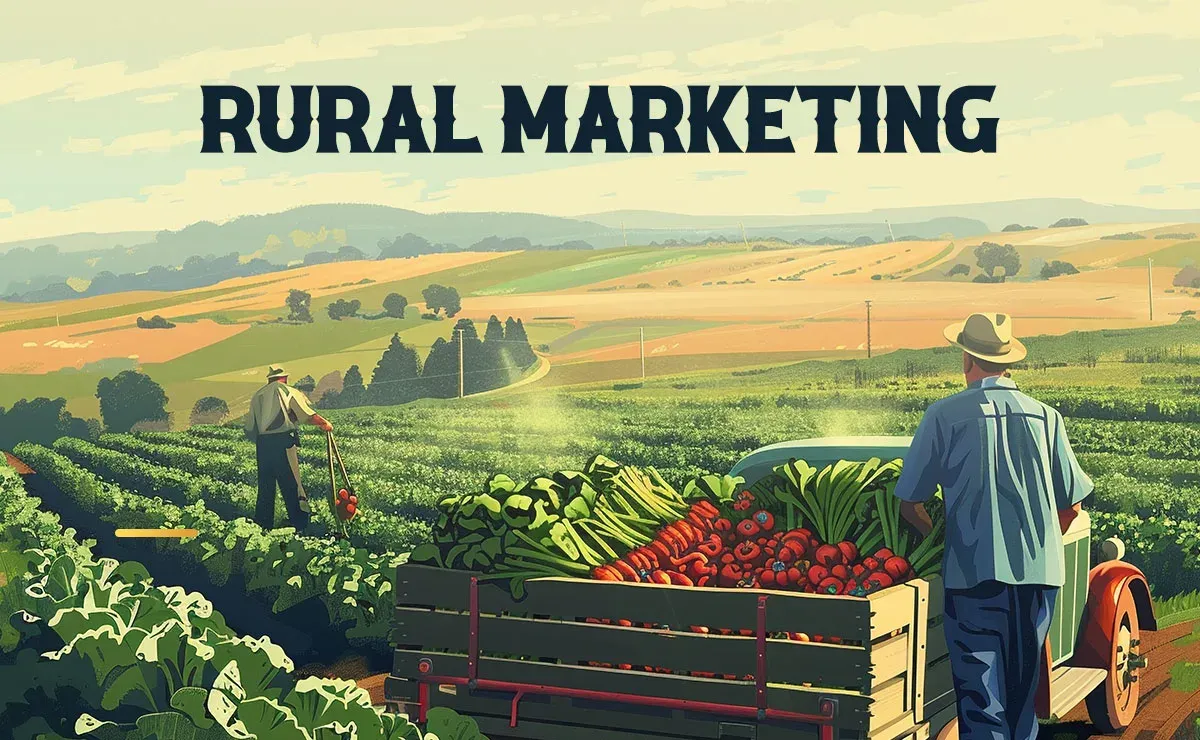What is Rural Marketing?

In India, where a large share of the population resides in rural areas, rural marketing is a targeted strategy to harness the untapped capacity for rural advancement and development.
Rural marketing developed to address the specific needs, tastes, and lifestyles of rural consumers. It fosters trust to drive product sales and ensures availability in widely dispersed and culturally varied regions.
Rural marketing presents opportunities to connect with previously untapped audiences and gain insight into the diverse behaviors of consumers. At Altera Institute, students gain practical insights and hands-on experience, equipping them to design effective strategies for rural markets. In the following sections, you will learn how our programs help you make an impact.
This article examines the significance and scope of rural marketing, exploring its importance, key strategies, evolution, and impact on economic development.
What is Rural Marketing with Examples

Rural marketing is not limited to the conventional buying and selling of agriculture. It is the marketing and selling of manufactured products, processed goods, and services to rural consumers and producers.
Contrary to an urban market where people are crowded, infrastructure is well-developed, and there are established buying behavioral trends, a rural market is spread out, heterogeneous, and sometimes needs specific approaches. For example:
- Project Shakti by Hindustan Unilever uses rural women as direct sellers and empowers them, making products more accessible.
- ITC’s e-Choupal connects farmers to markets, providing real-time information and creating better price opportunities.
These examples demonstrate how businesses tailor their strategies to meet the unique needs of rural markets.

Importance of Rural Marketing
The Economic Survey data 2021 states that 65% of India's population lives in rural areas and 42.3% depend on agriculture for livelihood. These population figures necessitate the fact that balanced economic and social growth is essential in the rural and urban settings to ensure the growth of the country as a whole.
1) Reduced Pressure on Urban Areas
Rural life becomes more viable due to the growth of rural marketing, which strengthens village infrastructure and employment options. This decreases the pressure on urban resources, since it limits rural-urban movement.
2) Catalyst for Economic Growth
Rural marketing enhances economic growth by leveraging the significant potential of rural consumers. Agriculture contributes 18.2 percent of the country's GDP, with an annual growth rate of 4.18 percent. This necessitates the development of rural markets that consequently increase agricultural productivity and drive the economy.
3) Employment Generation
Agriculture employs about 42.3% of India's population. Here, rural marketing generates jobs in related industries, such as agro-processing, logistics, and retail, in addition to farming. Employment in both rural and urban areas is boosted by this expansion.
4) Improved Living Standards
Rural marketing raises the standard of living in rural areas by providing access to high-quality products and services at reasonable prices. Good access to the market also increases the level of income, allowing rural regions to invest in improved housing, healthcare, and education.
5) Market Accessibility for Agricultural Produce
Rural marketing also enhances the distribution channel, providing farmers with the opportunity to sell their products directly to corporations or through intermediaries. This simplification increases the incomes and purchasing power of farmers since it ensures fair prices for agricultural products.
6) Improved Infrastructure
The growth of rural marketing is often accompanied by the development of transportation, banking, communication, and other essential infrastructure. Segmentation helps the business to focus on specific target populations within the market by dividing it into smaller sub-groups with similar needs and tastes.
Some of the strategies that can help marketers satisfy the special needs of rural consumers using available resources include undertaking activities that focus on specific types of products, customers, or a particular village.
7) Product Strategy
The preferences of rural consumers should be known to develop effective products. This involves focusing on:
- Value Proposition: Assuring that the product will offer some real advantages.
- Packaging: Simple, durable, and attractive packaging that aligns with rural expectations.
- Branding: It involves developing catchy logos and symbols that appeal to consumers with low literacy.
8) Pricing Strategy
In rural markets, competitive pricing is essential as price sensitivity is very high. Business organizations must develop cost-effective products that are affordable. Firms can serve the rural market without compromising on quality by providing smaller refillable packs and simplified products.
9) Competitive Strategy
Low awareness, counterfeit products, and unique consumer behaviors are some of the challenges businesses face before adopting competitive strategies in a rural environment. They may start by creating premium supply chains, educating consumers about the authenticity of their products, cultivating relationships with local stores, and developing barriers to new entrants.
10) Kiosk Setups
Kiosks can be established in busy places, which include marketplaces, schools, or post offices, where direct contact with the consumers is possible. These stores can be used to hold demonstrations and promotions, which can build trust and create awareness among rural customers.
11) Fairs and Events
Village fairs and melas contribute to the social and cultural life of rural people. Through these events, brands are able to display their products to a large number of people, reach potential consumers, and create a substantial presence in the rural market.
Features of Rural Marketing
Rural marketing focuses on the unique challenges and opportunities presented by the rural market, and the need to craft specific strategies to succeed. The main characteristics of rural marketing are the following:
1) Large and Scattered Population
The majority of the Indian population resides in rural regions, which are spread over more than 600,000 villages. This leaves a large and scattered market for businesses. Despite logistical challenges, the magnitude of this market offers great prospects for marketers to capitalize on.
2) Unpredictable Nature
Rural markets are volatile due to their inconsistent income and reliance on agriculture. The demand changes according to the monsoon cycle: during good harvests, there is a rise in spending, and in bad weather, the buying power declines.
3) Seasonal Demand
The demand in rural areas is highly seasonal, depending on agricultural seasons and local festivals. Staples, including farming inputs such as seeds and fertilizers, are in high demand during the sowing and harvesting seasons, and consumer goods are sold more effectively during the festive seasons.
4) Limited Infrastructure
Distribution and market access in rural areas are affected by infrastructure problems such as poor roads, unreliable electricity, and the lack of reliable communication. To overcome these logistical challenges and reach their target customers, companies often need innovative strategies to overcome the challenges.
5) Unique Marketing Mix
The urban marketing strategies cannot be directly translated into rural markets. Therefore, companies have to develop differentiated products, prices, marketing, and channels of distribution that are specific to rural consumers. Such a marketing mix should correspond to the individual preferences, affordability, and accessibility requirements of the rural people.
Scope of Rural Marketing
Rural markets have unquestionable potential. It presents numerous opportunities in various industries and sectors due to socio-economic growth, shifting consumer behavior, and emerging infrastructure. Below are the key areas that outline the vast scope of rural marketing:
1) Agriculture
Rural life is closely tied to agriculture, offering opportunities to sell essential agricultural inputs such as seeds, fertilizers, machinery, and irrigation devices. In addition, the growing focus on modern farming practices and contract farming is further causing the need to find novel solutions to agriculture.
2) FMCG Products
Among the daily needs of rural consumers are fast-moving consumer goods (FMCGs), including food products, hygiene products, and household appliances. As disposable incomes and better distribution networks increase, rural markets are also playing a significant role in FMCG sales, thereby providing long-term growth potential to businesses.
3) Healthcare Services
With the development of health awareness in rural communities, marketing can be utilized to increase the availability of affordable healthcare products, thereby promoting an improved quality of life in these communities.
4) Education and Technology
Rural marketing also encompasses the promotion of educational resources, including books and technology. As rural consumers seek improved educational opportunities, there is a growing demand for learning aids, affordable internet access, and mobile devices to help close the education gap.
5) Rising Rural Prosperity
Recent advancements in farming techniques, the growth of industrialization, and financial support from family members employed in cities or overseas have significantly increased rural incomes. This boost in economic well-being and status has led to increased buying power and greater accessibility to a wider range of consumer goods and services.
6) Growth in Consumption Patterns
The buying power of rural consumers is also increasing, and they are spending more on essential goods, branded items, and discretionary products. This growth in consumption is justified by the growth in per capita spending, which has led to a lucrative market in both basic and high-quality goods.
7) Changing Lifestyles
The rural consumer lifestyle is undergoing a significant shift in response to urban trends, which are now accessible through technology and media. This has accelerated the demand for products like personal care products, household appliances, and entertainment devices, thus presenting new opportunities to marketers.
8) Life Cycle Advantage
Products that have matured in urban markets frequently discover new growth opportunities in rural areas. For example, products such as soaps, talcum powder, and skin creams are still growing in rural areas, which allows companies to extend their product life cycles.
Classification of Rural Marketing
Rural marketing incorporates a number of strategies aimed at addressing the particular needs and characteristics of rural consumers. It may be classified based on products or services, market structure, and marketing mix.

Classification by Products/Services
Depending on the type of products or services sold, rural marketing can be divided into two broad categories:
- Agricultural Products: This encompasses products specifically designed for use in farming and agricultural purposes, including seeds, fertilizers, pesticides, irrigation equipment, and machinery. Such products play a major role in improving the productivity of agriculture and are specifically meant to satisfy rural consumers.
- Non-Agricultural Products: This group includes a wide variety of consumer goods and services such as vehicles, books, household appliances, and fast-moving consumer goods (FMCGs). Firms operating in this industry strive to cater to the evolving lifestyles and aspirations of rural consumers.
2) Market Structure:
There are two main types of rural market structure, depending on the method of distribution and sales:
- Primary Rural Market: In this type, companies deal directly with rural consumers, bypassing intermediaries. They frequently use direct distribution or eCommerce to have the products delivered directly to the final consumer, and this enables the supply chain to be better controlled.
- Secondary Rural Market: This model utilizes intermediaries, including dealers, retailers, and agents, to distribute products. It is also effective in accessing populations that are scattered, utilizing available networks to make goods available in different locations.
3) Marketing Mix
The rural marketing mix is based on four key elements that enable businesses to tailor their strategies to the rural markets:
- Product: It requires companies to customize or make their products more in line with the specific needs of the rural consumer, considering factors like affordability, durability, and practicality.
- Price: Pricing models must focus on the buying power of rural customers, with a greater emphasis on value and affordable products to encourage uptake.
- Promotion: Rural-based promotional activities, including localized advertisement, community involvement, and conventional media, are important in making sales.
- Placement: Effective product distribution channels, including local dealers, kiosks, and mobile vans, are utilized to make products accessible in remote and previously inaccessible locations.
Identifying these differences will enable businesses to cater to the unique needs of rural consumers and promote sustainable growth.
Evolution of Rural Marketing
The evolution of rural marketing can be categorized into four phases:
- Phase 1 (prior to 1960): Rural marketing was closely associated with agricultural marketing, focusing on the buying and selling of agricultural products and related goods.
- Phase 2 (1960 – 1980s): HUL was the first to venture into Indian rural marketing in the 1960s. They first made use of the existing urban distribution channel to reach the rural surroundings indirectly. Additionally, the Green Revolution (1967-68 to 1977-78) and the White Revolution (1970) ushered in a new era of rural prosperity, altering the demand cycle.
- Phase 3 (1990–2000): India witnessed the development of new service sectors as a result of the government's efforts to provide assistance to rural populations. Companies began releasing products to rural markets, which has transformed the agricultural sector into an industrial one.
- Phase 4 (After 2000): Businesses began employing rural residents to establish a presence in these territories, resulting in increased financial inclusion. Other programs like the Anganwadi program and midday meals also contributed significantly towards an increase in literacy as well as improvement in livelihood in the rural regions.
The latest technological innovations and the introduction of new communication channels have transformed rural marketing. Previously considered an unprofitable market, rural locations are now regarded as a highly promising market, attracting businesses.
Factors Affecting Rural Marketing
In India, rural marketing is influenced by a variety of factors that affect its development, challenges, and prospects. Businesses that are aiming to succeed in rural markets should not ignore these factors.
1) Professionalization of Marketing
The recognition of marketing as a professional field has been of great significance in the development of rural markets. These markets have achieved increased efficiency and productivity with the help of committed professionals who focus on marketing strategies.
2) Rapid Urbanization
The rural-urban migration of people seeking education, employment, and business opportunities has indirectly led to the development of rural marketing. Not only does this movement allow the sale of rural goods in urban markets, but it also exposes rural buyers to new items and trends, thus creating a relationship between urban and rural demands.
3) Improved Transportation and Communication
Modern transportation, communication infrastructure, road accessibility, improved logistics, and advanced communication technologies have expanded the markets for agricultural and rural products. These kinds of developments ensure that farm produce is not only confined to local consumption but can also be expanded nationwide.
4) Technological Advancements in Agriculture
Technological advancements in agriculture have paid off in increased productivity and surplus production. This excess has led to the growth of rural marketing, driven by the increased availability of products that can be distributed and sold. Mechanization, improved irrigation, and enhanced farming practices have enabled this growth.
5) Cooperative Marketing Initiatives
Rural markets need cooperative marketing arrangements. State marketing boards head the system at the top, then there are district-level or block-level primary marketing committees. This collaborative system enhances proper management of farm products. Typically, these institutions are state-controlled and play a role in regulating prices and distribution, as well as shaping the overall structure of the markets, which enhances rural marketing.
Objectives of Rural Marketing
Rural marketing has the aim of targeting the enormous potential that exists in rural markets and addressing the demands of rural consumers. Here are the main objectives:
1) Market Penetration:
- To tap into the rural markets and create a strong presence by serving their needs and preferences.
- To boost market share by adding products and services that meet the needs of rural consumers.
2) Enhancing Accessibility
- To ensure the availability of products and services in remote and underserved rural areas.
- To improve the distribution network and make their products accessible to all consumers.
3) Creating Awareness
- To inform rural consumers about products, services, and their benefits by using targeted marketing campaigns.
- To address information gaps through the utilisation of local communication channels.
4) Promoting Economic Development
- To help rural development through the delivery of modern tools, technologies, and services.
- To assist the rural economy by creating employment through local alliances.
5) Profitability and Sustainability
- To harness the untapped potential of rural markets to generate revenue and to ensure sustainable business operations.
- Market strategies should be developed that are cost-effective to meet the requirements of rural customers.
The Pros and Cons of Rural Marketing
The merits and the demerits of rural marketing are as follows:
Criteria | Advantages | Disadvantages |
Market Potential | Large untapped market with significant growth opportunities. | Seasonal demand limits consistent sales throughout the year. |
Competition | Low competition enables better market capture and customer loyalty. | Limited distribution networks hinder product availability. |
Marketing Costs | Lower marketing costs as fewer promotional activities are needed for market penetration. | Inadequate media coverage makes promotions challenging and less effective. |
Consumer Behavior | By addressing unique requirements, businesses can foster a loyal customer base. | Traditional outlook and skepticism lead to slower purchasing decisions. |
Information Access | Opportunity to educate consumers and create awareness for new products. | The lack of access to information often hinders rural consumers from making well-informed choices. |
Rural Marketing Components
Rural marketing has diverse essential elements that enable businesses to reach, communicate, and service rural consumers effectively. Below are the key components:
1) Understanding Rural Demographics
- It is essential to be aware of the diverse age groups, income levels, educational statuses, and occupations within rural areas so that specific marketing strategies can be developed.
- A nuanced understanding of geographical features enables companies to create campaigns that resonate with rural customers.
2) Market Research
- Carrying out a detailed study to reveal the local taste, shopping habits, and cultural peculiarities.
- Through this, businesses can recognize specific needs and tailor their products and strategies to meet the expectations of rural consumers.
3) Product Adaptation
- Adapting the products to the lifestyle, tastes, and income of rural buyers.
- Small-sized and affordable product packages, as well as durable and easy-to-repair machinery, are examples of ways to promote accessibility.
4) Pricing Strategies
- Coming up with low-pricing strategies to serve the rural markets that are price-sensitive.
- Such strategies as installment plans or government subsidies can make products more accessible.
5) Promotional Campaigns
- The development of culturally relevant campaigns that would make the most out of local traditions, fairs, and festivals.
- The use of local media and influencers in the community intensifies brand awareness.
6) Government Policies and Regulations
- Keeping abreast and in line with government policies, which affect pricing, subsidies, and distribution.
- Agricultural schemes or subsidies also allow businesses to devise targeted offers to rural consumers.
7) Training and Skill Development
- Offering training programs to rural communities, such as modern farming techniques or financial literacy, fosters goodwill.
- This not only enhances community well-being but also strengthens the business’s reputation.
What are the Four A’s of Rural Marketing in India?
The 4 A of rural marketing include Affordability, Availability, Acceptability, and Awareness. It offers a good guideline on how to develop effective strategies to reach rural consumers. These elements address specific challenges and opportunities that exist in rural markets.
1) Affordability
Rural consumers, whose income is usually lower, focus on essential items and expect to receive good value for their money. Marketers need to ensure that their products are affordable to attract rural consumers. The basic needs must be fulfilled at low expense, which will help in building trust and loyalty among rural families.
2) Availability
A significant challenge in rural marketing is maintaining a steady supply of products. Since rural consumers depend on daily essentials, they are likely to switch to other options if their favorites are out of stock. Creating effective distribution networks is crucial for delivering products efficiently, ensuring accessibility, and fostering brand trust.
3) Acceptability
One major problem with rural marketing is the issue of a constant supply of goods. As a rural consumer is reliant on daily necessities, other alternative products are most likely to be purchased when preferred products are out of stock. Hence, developing well-coordinated distribution channels is crucial for bringing products to market effectively, making them accessible, and fostering brand loyalty.
4) Awareness
It is essential to establish brand awareness in rural markets, where people may not be familiar with any particular brand or specific product. Effective marketing campaigns are expected to utilize various communication media, including television, radio, and outdoor advertising, among others, to inform and educate target consumers. Such campaigns should be approachable, culturally relatable, and appealing to rural audiences.
Successful Case Studies of Rural Marketing in India

We will learn about the case study of Hindustan Unilever Limited (HUL) in rural marketing. HUL has developed a strong distribution channel to reach rural India efficiently by utilizing creative strategies to address the unique demands of the markets. Key initiatives include:
1) Phased Distribution Evolution
- Initial ways included direct orders with wholesalers and company salesmen distributing goods.
- The introduction of Redistribution Stockists (RS) enhanced the coverage, warehousing, and demand creation.
- The shift to the third-party Carrying and Forwarding Agents (C&FAs) simplified logistics, minimized expenses, and enhanced the ability to find stock.
2) Technology Integration
- RS Net and Project Leap combine IT solutions for real-time order tracking, supply chain optimization, and increased service to retailers.
3) Rural-Focused Strategies
- Indirect Coverage: Accessible villages serviced via urban networks.
- Project Streamline: Expanded direct reach through sub-stockists in smaller villages, utilizing cost-effective transport methods.
- Operation Harvest: A product awareness activity involving vans and an event at a local cinema to attract rural consumers.
4) Project Shakti
- A flagship program that would enable rural women who became self-help groups (SHG) or Shakti Ammas to sell HUL products in remote villages. This model not only developed sustainable livelihoods but also increased HUL's reach to more than 100,000 villages and over 3 million households.
The emphasis on affordability, availability, and local empowerment has enabled HUL to build a self-sustaining ecosystem that has driven rural penetration, consumer loyalty, and the inclusive development of underserved markets.
FAQs
Q1. What is the purpose of rural marketing?
Ans: Rural marketing helps businesses connect with rural consumers by understanding their preferences, challenges, and needs. It focuses on creating awareness, promoting product availability, and fostering trust within these communities.
In marketing management strategy, rural marketing is crucial in ensuring that prices, promotions, and products offered are tailored to the rural lifestyle. It also deploys new forms of distribution to inaccessible locations.
Q2: What are the 4 Ps of rural marketing?
Ans: The 4 Ps of rural marketing are:
- Product: Inventing products that are responsive to the rural needs, including affordability, durability, and use in rural set-ups.
- Price: Providing low-cost pricing policies to serve the low-income group of the rural population.
- Place: Establishing effective distribution networks in order to make products reach the remote regions.
- Promotion: Development of campaigns based on media that are available to rural populations, including radio, local events, and grassroots outreach.
Summing Up
Rural marketing plays a crucial role in enhancing the growth of these economies by linking rural areas with urban centers and improving the livelihoods of people living in less developed regions. Businesses can unlock the huge market potential of rural markets by taking a tailored approach that focuses on affordability, accessibility, acceptability, and awareness.
Examples like HUL’s Project Shakti demonstrate how innovative approaches can empower communities and broaden market access. By addressing the specific challenges and capitalizing on the opportunities available in rural India, companies can achieve sustainable growth and play a significant role in the country’s overall development.





